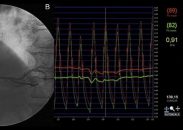Assessing intermediate coronary lesions with intracoronary physiology tests such as fractional flow reserve (FFR) or other non-hyperemic indices is considered the standard of care by both American and European societies. Likewise, intravascular imaging techniques (IVI), be it IVUS or optical coherence tomography (OCT), are of great use in assessing and guiding complex coronary lesions and…
Post PCI Functional Assessment for Focal Lesion and Stent Underexpansion Detection
The use of fractional flow reserve (FFR) and non-hyperemic pressure indices (NHPRs) have become essential for intermediate lesion revascularization. A linear inverse correlation has been recently shown between the use of post PCI physiology and cardiovascular events at followup. However, its adoption has been limited so far, seeing the wide variety of algorithms used in…
Trans-Stent Gradient as a Predictor of Adverse Events at Followup
Stenting a coronary lesion should not present a drop in pressure when measuring the treated segment with fractional flow reserve (FFR). FFR based trans-stent gradient should involve a segment of the sub-expanded vessel or instent obstruction as plaque prolapse or thrombus. The link between post-stenting physiology and long-term outcomes have been looked at in several…
Use of OCT FFR on ACS Clinical Outcomes
Patients undergoing acute coronary syndrome (ACS) benefit from percutaneous coronary intervention (PCI). At present, there is no question about this. However, residual ischemia after PCI is associated with a worse prognosis. Angiography studies and intravascular imaging are useful to assess post intervention outcomes, but they are limited when it comes to the physiological assessment of…
TCT 2022 | FAME-3 Trial: post PCI FFR And IVUS in Patients with Three-Vessel Disease
We are well aware of the benefits of Fractional Flow Reserve (FFR) to assess coronary artery stenosis. FFR after PCI (post-PCI FFR) has been shown to have prognostic value; however, few studies have included patients with complex three-vessel disease. The impact of intravascular ultrasound (IVUS) or optical computer tomography (OCT) in this field has been…
RIPCORD 2 Study: Routine Assessment Using Pressure Wires in Acute Coronary Syndrome
The inclusion of fractional flow reserve (FFR) has changed how coronary interventions are treated. Current guidelines endorse its use in intermediate lesions with no evidence of ischemia in non-invasive studies in patients with multivessel disease. The original RIPCORD (Routine Pressure Wire Assessment Influence Management Strategy at Coronary Angiography for Diagnosis of Chest Pain) study proposed…
Are FFR and IVUS Similar to Assess Intermediate Lesions?
In coronary artery disease (CAD), lumen area and plaque burden, characteristics and physiological impact are what define prognosis. At present, coronary angiography continues to be the gold standard for CAD assessment. When considering PCI to treat intermediate lesions, FFR has been shown beneficial and safe. Not yet IVUS. 1682 patients with intermediate lesions (40 –…
Coronary Physiology Is Useful in Chronic Kidney Disease
Coronary physiology, FFR and iFR, has been shown safe to defer lesions and effective to save stents by different randomized studies and registries. However, patients with chronic kidney disease have not been thoroughly analyzed yet, which brings us to the question about what to do in the face of their negative evolution, when atherosclerosis develops…
FFR and IFR: Are We Talking About the Same Thing?
To evaluate borderline coronary lesions (a 40% to 70% obstruction), determining associated ischemia is paramount. For this purpose, pressure gradients are measured across the stenosis. These measurements can be hyperemic, such as the fractional flow reserve (FFR), or taken at rest, such as the instantaneous wave-free ratio (iFR). According to the iFR-SWEDEHEART 5-year follow-up outcomes,…
Is iFR Reliable After 5 Years? Analyzing the iFR-SWEDEHEART at 5 Years
Fractional flow reserve (FFR) proved to be very useful and safe in the FAME study, but its trade-off was using adenosine (which has a short half-life) and adverse reactions, which fortunately were rare. Subsequently, two large studies—the iFR-SWEDEHEART and DEFINE-FLAIR—demonstrated that instantaneous wave-free ratio (iFR) offered comparable results to FFR in the short term, avoiding…









